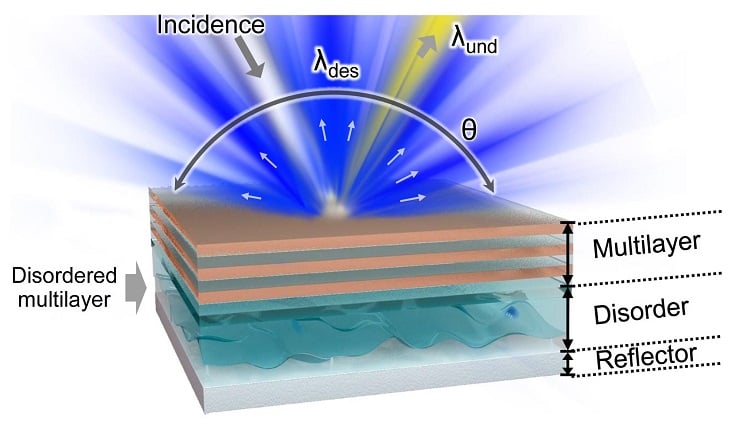Passive cooling with a colorful bio-inspired film
S. Himmelstein | August 23, 2023 The blue version of the films uses a multilayer structure designed to reflect yellow light in a very narrow range of angles while the disordered glass structure diffuses the blue light across a broad area. A silver reflection layer prevents absorption of solar radiation and the associated heating. Source: Wanlin Wang, Shenzhen University
The blue version of the films uses a multilayer structure designed to reflect yellow light in a very narrow range of angles while the disordered glass structure diffuses the blue light across a broad area. A silver reflection layer prevents absorption of solar radiation and the associated heating. Source: Wanlin Wang, Shenzhen University
Building facades, motor vehicles and other structures can keep their cool and exterior colors with a new non-heat absorbing film inspired by the Morpho genus of neotropical butterflies. The design of the cooling nanofilm mimics the nanostructure of the butterfly wings, which retain their vibrant colors without absorbing light and generating heat.
The film was assembled by researchers from Shenzhen University and Shanghai Jiao Tong University, China, by placing rough frosted glass under a multilayer material made of titanium dioxide and aluminum dioxide. This structure is then joined with a silver layer that reflects all light, thus preventing the absorption of solar radiation and the heating associated with that absorption.
The color of the film is governed by how components within its multilayered structure reflect light. A blue hue is fashioned when the multilayer material is designed to reflect yellow light in a very narrow range of angles while the disordered glass structure diffuses blue light across a broad area.
This approach to passive photonic thermal management was tested by applying blue, yellow and colorless films to cars, cloth, roofs and other outdoor surfaces in both winter and summer at Shenzhen University. Data from thermocouple sensors and infrared cameras demonstrated that the cooling films were more than 15° C cooler than the surfaces on which they were placed in the winter and about 35° C cooler in the summer.
Substituting an aluminum layer for the silver film will lower material costs and support production by scalable fabrication methods such as electron beam evaporation and magnetron sputtering. The researchers will next seek to enhance the mechanical and chemical properties of the passive cooling film described in Optica.




